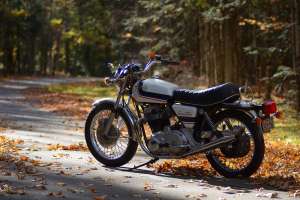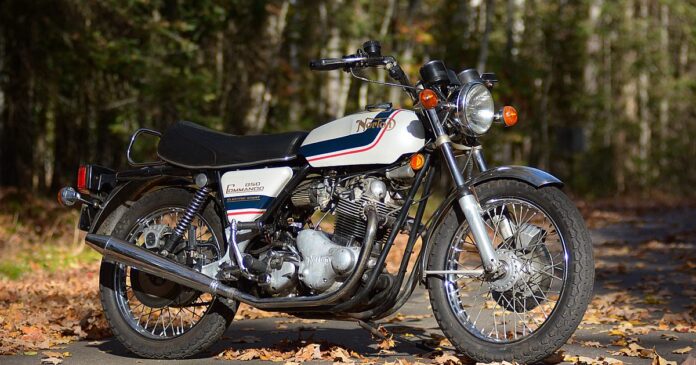The year was 1975, and the writing was on the wall for the Brits. Decades of industry dominance were coming to a close in the blink of an eye as multi-cylinder options from Japan proliferated. Honda had rewritten the book with the CB750, Suzuki had the 70 hp GT750 and the Kawasaki Z1 had solidified the fact that four-stroke, four-cylinder engines would power the civilized sport bike of the future. The best of the old-world Brits had been grouped into the troubled conglomerate of Norton Villiers Triumph for their respective Hail Marys, relying on tradition, superior handling and good old-fashioned parallel twins, but could the old formula still work?
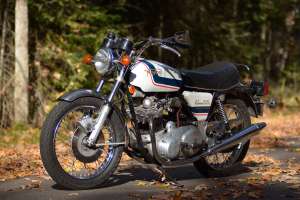
While the story of Japan’s rise to the top of the motorcycle industry is well documented, Britain’s reaction has received significantly less attention. There are few better machines to tell the story than the Norton 850 Commando, and since I’ve been afforded the opportunity to spend the day with one, it seems only right to explore that narrative from the most fitting place—the saddle. So bear with me as we talk a little history, but only as it relates to the feel of this 50-year-old motorcycle, which is currently available on the Bike EXIF Auctions.
Its styling was tried and true (at best) by 1975, but there can be no doubt this 850 Commando has some serious parking-lot presence today. It’s low and muscular, with a pair of 19-inch spoked hoops and Lockheed disc brakes making its intentions clear. The 828 cc parallel-twin has been canted forward for visual effect and its upswept exhausts arch purposefully from tip to tail.
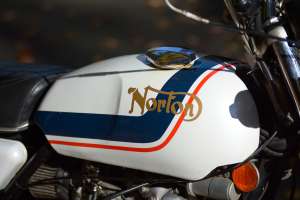
Next to the other paint options available for 1975, this 850 Commando is particularly eye-catching with its pearl-white paint fronted by red and blue stripes and gold lettering. Norton called it the ‘Blue Stripe Finish,’ and it’s frequently associated with the John Player Special Commandos of the time period. While the factory made no connections between the JPS machines and the Blue Stripe, I think it’s reasonable to assume that Norton would leverage any connections they had at the time, and the influence is there if nothing else.
The starting procedure is antiquated, even compared to the age of the machine. Click the key all the way to the right, turn on the dual petcocks, dial in the long throw of the cable choke and plunge the Amal carburetors ‘tickler’ primers a handful of times each. If you’ve done it all just right, the parallel twin fires with little fuss and settles down to a lopey idle. Considering ’75 was the first year for electric start, and they immediately gained a poor reputation for cold starting, this one works flawlessly.
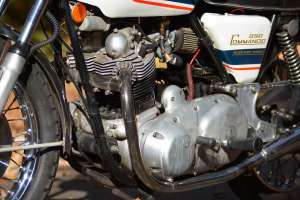
Aside from the throaty huff from the reverse cones, there’s a healthy ticking from the overhead valvetrain, with the manually-adjusted tappets sounding perfectly in spec. A tactile notch from the pre-unit four-speed accompanies the shift into first gear, and the Commando is in motion with little drama to speak of. Despite its presence and noticeable 490-pound heft, it’s easy to get the big Norton moving, largely due to the torquey nature of the long-stroke engine.
While the Smiths tachometer has left the chat on this particular motorcycle, the pleasant demeanor of the 850 parallel twin is obvious from the seat of the pants. The engine pulls hard from low revs up beyond the mid-range. It doesn’t sound angry or ragged in any way, and plods along dutifully through its long gears, achieving comfortable highway speeds easily in third gear. That’s not to say that it’s not responsive; as a quick wrap of the throttle on downshifts readily brings the revs up for smooth deceleration.
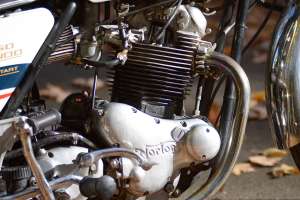
History could have been kinder to the 850. It wasn’t as high-strung as the notoriously unreliable 750 Combat engine and lost a few ponies along the way. Top speed was also down to around 105 mph for the Mk3, and peak power comes in 1,000 rpm lower in the rev range. These improvements did make for a much more reliable cycle, though, and the 850 wasn’t prone to the same bearing and piston failures as the 750, and didn’t mark its territory with oil as profusely.
While you could glean all the same information with a Google search, some things just don’t translate from the spec sheet to the real world, especially 50 years later. Removed from the top-speed wars of the ’70s, the 828 cc parallel twin is sublime on the street. It motivates with a long, consistent push that puts you into misdemeanor territory surprisingly quickly. The bike feels stable and composed at speed, and I can still envision it being an excellent vintage touring machine today, thanks to its tall gearing.
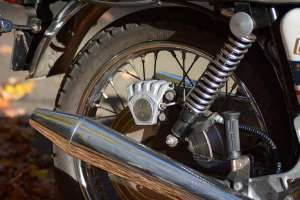
And it still handles well. The last bastion of British motorcycle excellence was handling, something the early Japanese frames couldn’t match. It corners well, even by today’s standards, and the neutral seating position keeps you in control without sacrificing comfort. The dual Lockheed discs perform admirably, even if the front pot lacks the bite we’re accustomed to from modern machines.
There is one peculiar aspect of the Commando’s handling, and it comes down to the Isolastic frame. Painting in broad strokes, these big parallel twins vibrate like a Harley, and Norton devised a rubber-mounting system to tame the shakes. In the production Commando, the Isolastic system mounted the swingarm directly to the engine mounting plates, ensuring that distortion from the rubber mounts wouldn’t lead to chain alignment issues.
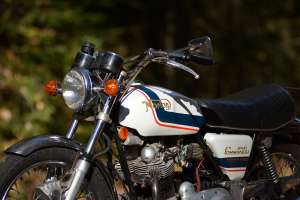
Call it a placebo effect, but you can feel the engine pull the driveline to one side when you throttle on while cornering. Apparently, it’s known as ‘the hinge’ in Norton circles, and while the effect was negligible at the speeds I was operating, I did notice it. And even with that facy Isolastic frame, this thing sure vibrates like an SOB at stop signs. The bars shake, you can feel it in your eyes and the mirrors fight a losing battle to stay pointed in the right direction.
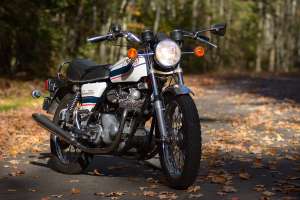
But all that fades away at speed, and the miles fly by effortlessly—I could easily ride this bike all day long. And that, I think, is the genius of the 850 Commando. It has the charisma and presence that made Norton one of the best bikes money could buy, but they’ve had the time to work the kinks out. It was the final flourish of the classic British motorcycle era—a machine that arrived just as the Japanese were rewriting the rules, yet somehow managed to hold its own, and still does so today.
Although my day with this motorcycle came to an end, it could mark the start of yours. This unmolested 850 Commando survivor is currently up for grabs on the Bike EXIF auctions and is ripe to be taken to the next level or, simply, enjoyed as is. I certainly enjoyed my time with it, and to the winning bidder, I apologize for running up the odometer—NOT.
